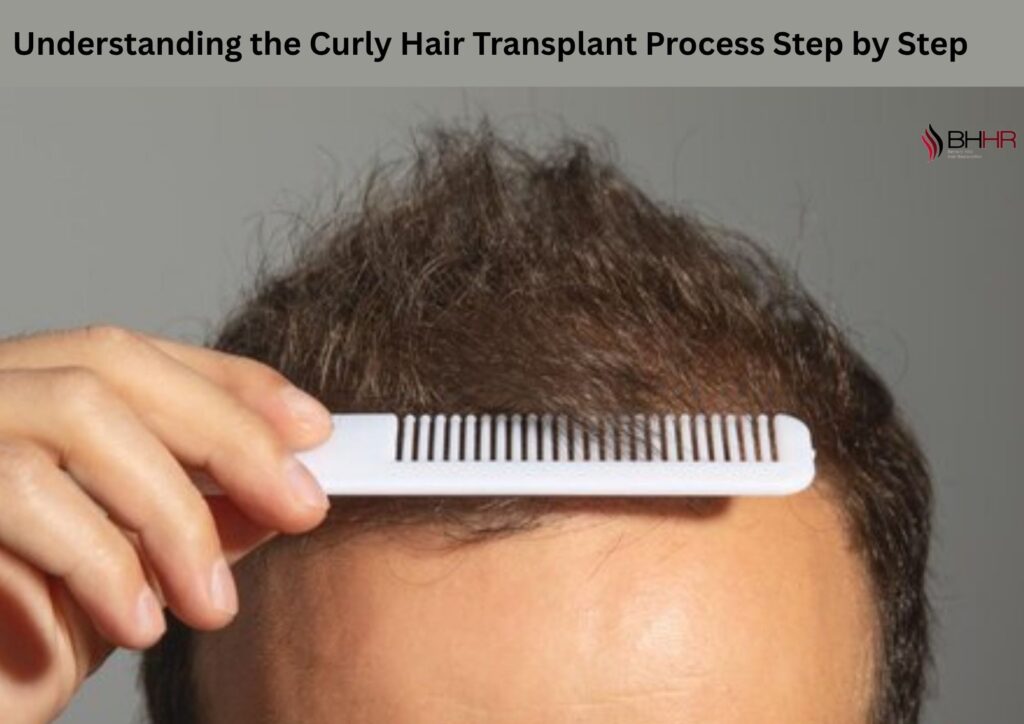Achieving natural-looking results through a curly hair transplant needs a clear understanding of the unique attributes of curly hair and a meticulous approach at every stage. Many people with curly or textured hair feel concerned about thinning edges, receding hairlines, or bald patches, yet they hesitate because they fear the procedure won’t match their hair’s natural curl pattern. If you’ve been wondering how a curly hair transplant works, this complete guide breaks down each step of the process so you can make an informed decision with confidence.
Why Curly Hair Transplants Are Different
Curly hair has distinct traits that make the transplant process more complex than straight hair procedures. Each curly hair strand grows from a curved follicle, which means that harvesting and implanting these follicles demands more precision. Additionally, the curl pattern must be preserved so the new growth blends seamlessly with existing hair.
Unlike straight hair, curly hair can provide better coverage because the curls create volume and density. However, because the follicles are curved beneath the skin’s surface, the surgeon must extract and implant them at precise angles to avoid damaging them. A successful curly hair transplant not only restores hair but also maintains the natural pattern and texture.
Initial Consultation and Assessment
Every successful curly hair transplant starts with a thorough consultation. During this appointment, the surgeon evaluates the patient’s scalp, hair type, curl pattern, and overall health. A detailed discussion helps set realistic expectations and clarifies the goals of the procedure.
The consultation typically involves:
- Reviewing medical history and any previous hair loss treatments
- Examining the donor area, usually the back and sides of the scalp
- Identifying the extent of hair loss and potential causes
- Determining if the patient is a good candidate for the process
This step is crucial because not every hair loss case requires or benefits from surgical intervention. For those with significant curl patterns, the surgeon will consider how to best replicate the natural look.
Designing the Hairline
One of the most critical aspects of a curly hair transplant is designing a natural-looking hairline. For people with curly hair, the hairline design must respect the natural flow of curls. This involves planning the density, angles, and direction of transplanted follicles to match surrounding hair.
Surgeons often use detailed sketches or digital imaging to show the patient how their new hairline will look. This collaborative approach ensures the patient is comfortable with the shape, height, and overall appearance.
Preparing for the Procedure
Once the plan is set, the patient will receive pre-operative instructions. Preparing for a curly hair transplant may include:
- Avoiding smoking and alcohol, which can affect recovery
- Stopping certain medications, under medical guidance
- Washing the hair thoroughly the night before surgery
- Arranging for transportation, as patients shouldn’t drive home immediately afterward
Patients should also plan time off work and prepare for aftercare needs, such as mild swelling or redness around the transplant area.
Harvesting Donor Hair
Harvesting donor hair is the next crucial step in the curly hair transplant process. There are two primary techniques for extraction: smart Follicular Unit Extraction (FUE) and smart Follicular Unit Transplantation (FUT).
Smart Follicular Unit Extraction (FUE)
Smart FUE is a popular choice for curly hair because it extracts individual follicular units directly from the donor area. The surgeon uses a technical punch tool to remove each follicle with minimal scarring. However, extracting curly hair follicles is trickier than straight hair because the follicle’s curl extends below the skin.
To prevent transection (cutting the follicle and damaging it), the surgeon must follow the curl’s natural angle and curvature beneath the skin. This requires great skill and experience.
Smart Follicular Unit Transplantation (FUT)
FUT, also known as the strip method, involves removing a thin strip of scalp from the donor area, then dissecting it under a microscope to separate individual follicular units. This method can be effective for curly hair because it allows technicians to carefully prepare grafts while minimizing follicle damage.
Both methods have their benefits and drawbacks, and the right option depends on the patient’s hair type, goals, and the surgeon’s expertise.
Preparing the Grafts
After extraction, the harvested follicles are examined and sorted. Technicians clean each graft under magnification to ensure they’re healthy and intact. For curly hair, extra care is taken to maintain the curl pattern during preparation. The goal is to provide that once implanted, the new hair grows in the correct direction and maintains its natural texture.
Creating Recipient Sites
The surgeon then prepares the recipient area where the new hair will be implanted. This involves creating tiny incisions at specific angles and depths. For curly hair, the angles must follow the natural curl to prevent awkward growth patterns.
A well-prepared recipient site ensures the hair grows naturally and blends with surrounding hair. This step requires an artistic eye as well as technical skill.
Implanting the Follicles
Next comes the implantation of grafts into the recipient sites. Each graft is carefully placed by hand to ensure precise alignment with the natural curl. The surgeon will pay close attention to the density and direction of placement.
The implantation process can take several hours, depending on the number of grafts. Patients are typically awake during the process but under local anesthesia, so there is no pain during the surgery itself.
Immediate Post-Procedure Care
After the curly hair transplant, the patient receives instructions for immediate care. Common post-procedure guidelines include:
- Keeping the transplanted area clean and dry
- Avoiding touching or scratching the scalp
- Sleeping with the head elevated to reduce swelling
- Using prescribed medications to prevent disease and promote healing
Some redness, swelling, or mild discomfort is normal and usually subsides within a few days.
Hair Regrowth Timeline
Full results from a curly hair transplant take time to develop. Typically, new hair starts to appear about three to four months after surgery. The hair grows gradually, and significant changes are usually visible around six to nine months.
By twelve months, most patients see the final results, with hair that matches their natural curl pattern and density. The transplanted hair will continue to grow intrinsically, just like the surrounding hair.
Long-Term Care and Maintenance
Once the new hair is fully grown, supporting healthy hair is key to maintaining it looking its best. Good habits for post-transplant hair care include:
- Using gentle, sulfate-free shampoos
- Avoiding excessive heat styling or harsh chemicals
- Staying hydrated and eating a balanced diet
- Scheduling periodic check-ins with a hair specialist if needed
While the transplanted hair is endless, some patients may choose to have touch-up procedures in the future if further thinning occurs elsewhere.
Common Questions About Curly Hair Transplants
Is a curly hair transplant permanent?
Yes, the transplanted hair is typically permanent because the follicles come from areas resistant to pattern baldness. However, natural aging may cause hair thinning over time, so ongoing care is important.
Does the curl pattern really stay the same?
When performed correctly, the curl pattern should stay intact because the transplanted follicles retain their original characteristics. Choosing a skilled surgeon who understands curly hair is essential.
Are curly hair transplants painful?
Patients usually experience minimal pain during the process due to local anesthesia. Mild discomfort afterward is normal but manageable with prescribed medication.
Can I wear protective styles after a curly hair transplant?
Once the transplanted area is fully healed and the hair has grown sufficiently, protective styles like braids or twists are possible. However, it’s best to wait several months and get professional advice before styling.
Choosing the Right Surgeon for Curly Hair
Because curly hair is more complex to work with than straight hair, it’s vital to choose a surgeon with specific experience in textured hair restoration. Look for a professional who has a proven way record, clear before-and-after photos, and a deep understanding of curly hair’s unique challenges.
Tips for a Smooth Recovery
Here are a few extra tips for a stress-free recovery:
- Follow all post-operative instructions carefully.
- Stay hydrated and eat nutritious foods to support recovery.
- Avoid strenuous activities for the first week.
- Be patient — results take time, but the result is worth it.
Conclusion
A curly hair transplant is a powerful option for restoring trust and achieving a fuller, natural-looking head of hair. By understanding the step-by-step process, from consultation to final results, patients can feel informed and empowered to make the best choice for their unique hair type.
Curly hair transplants require extra precision, experience, and care — but when done right, the results speak for themselves. If you’re considering this transformative journey, take time to learn, plan, and choose a skilled specialist who respects and celebrates your natural curls. Your path to beautiful, healthy hair is within reach — one curl at a time.
- Understanding the Curly Hair Transplant Process Step by Step
- Learn the curly hair transplant process step by step, from consultation to recovery, for natural, defined curls and restored confidence.
- Curly hair transplant
Related posts:
 The Rise of the Probiotic Drink: A Wellness Staple for Gut and Liver Health
The Rise of the Probiotic Drink: A Wellness Staple for Gut and Liver Health
 Inside the Mind of Jack Allen: Crafting Military Thrillers That Grip You
Inside the Mind of Jack Allen: Crafting Military Thrillers That Grip You
 Eye Hospitals in Visakhapatnam: Advancing Vision Care in Coastal Andhra
Eye Hospitals in Visakhapatnam: Advancing Vision Care in Coastal Andhra
 What Happens If I Stop Getting Anti-Wrinkle Treatments? – Learn
What Happens If I Stop Getting Anti-Wrinkle Treatments? – Learn
 Nature’s Wrap: Exploring the Biodegradable Packaging Revolution
Nature’s Wrap: Exploring the Biodegradable Packaging Revolution
 Ashtanga Hridayam Book : The Essence of Ayurveda with CSS Banaras
Ashtanga Hridayam Book : The Essence of Ayurveda with CSS Banaras
 How the Neurology and Mental Health Conference 2025 Empowers Patients
How the Neurology and Mental Health Conference 2025 Empowers Patients
 Dentist in Largo Florida – Expert Care with a Personal Touch at Blue Dental Largo
Dentist in Largo Florida – Expert Care with a Personal Touch at Blue Dental Largo








